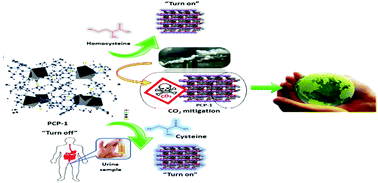Exploratory studies of a multidimensionally talented simple MnII-based porous network: selective “turn-on” recognition @ cysteine over homocysteine with an indication of cystinuria and renal dysfunction†
Abstract
Selective sensing of biothiols holds immense importance due to the adverse roles of abnormal concentrations of biothiols in several diseases, henceforth demanding widespread research for developing a sensory receptor towards the selective detection of biothiols. Herein the designed synthesis of a simple 3D porous coordination polymer, PCP-1 has been carried out following a conventional solvothermal reaction route that shows selective sensing of biothiols (Cys & Hcy) at the nanomolar level with a very short response time carrying enormous importance for simplistic biological studies. Due to the presence of paramagnetic metal centres, MnII-MOF itself remains in a quenched state that shows selective “turn-on” fluorescence response in the presence of electron-rich biothiols which was thoroughly studied by DFT. In continuation, the sensor PCP-1 was equally responsive in different biological matrices such as fresh bovine serum and human urine showing the bio-applicability of the porous network which is of immense importance in analytical domains in the modern era. Thus, the detection of biothiols from human urine would be enormously helpful in preparing a paediatric reference range for clinical use. As a result, the detection of either cystinuria or homocystinuria in patients will be done with ease. Additionally, PCP-1 has selective adsorption capability of CO2 over N2 at low temperature with the aid of the size-exclusion effect of interstitial channels along with the dipole–induced dipole interaction. The magnetic properties of the framework, PCP-1 indicate weak anti-ferromagnetic coupling between the MnII centres of the trinuclear building block. These two hidden potentials may be properly utilised in the domain of GHG mitigating agents and spintronic applications, respectively.



 Please wait while we load your content...
Please wait while we load your content...